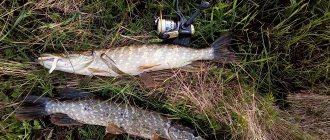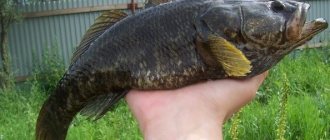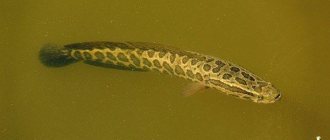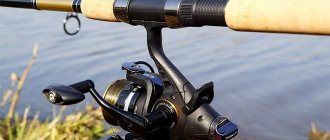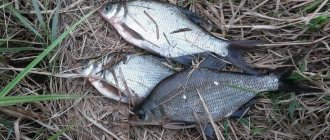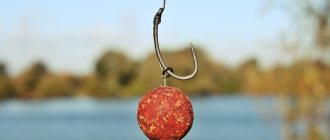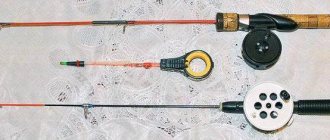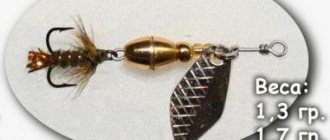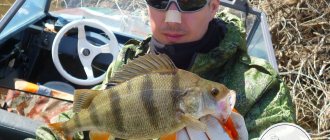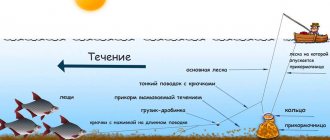Taimen is the largest representative of the salmon family. It can reach a weight of over 60 kg and a length of 1.5 meters. But in fact, no one knows exactly what length and weight this fish can actually reach, because it lives mainly in inaccessible bodies of water, which can only be reached by helicopter. But nevertheless, this did not save this magnificent fish from ending up in the Red Book. Fishing for taimen is prohibited in many rivers of Siberia. Taimen is a lover of cold, crystal-clear water. Such water can only be found far from civilization, in the taiga, in fast mountain rivers. The habitat of taimen is all large reservoirs of Siberia, the Far East, Altai and the northern regions of Kazakhstan. Taimen lives exclusively in fresh water and does not enter the sea from rivers. With the exception of the Sakhalin taimen, which lives in the Sea of Japan and enters rivers only to spawn. Sakhalin taimen is the only anadromous representative of taimen.
Where is taimen found in Russia?
The habitat of our today's hero extends from the Trans-Urals to the Far East. The taimen fish is found in the basins of large Siberian and Far Eastern rivers, among which the Lena, Yenisei, Amur, and Lake Baikal stand out. The further north the region, the higher the number of this representative of salmon fish, and it is larger in size. Southern Siberia, the Sayan Mountains and Altai, once famous for their catches, have now lost their leading position in the number of taimen, and meeting them in the rivers of these regions has become a great rarity and incredible luck for a fisherman.
The fish avoids industrial areas near large cities and looks for secluded areas for living in calmer and cleaner waters, avoiding polluted reservoirs with low oxygen concentrations in the water. You can find a large population of the Red Book fish outside of untouched areas, remote from civilization, where, in principle, fishing tours are organized by a few agencies specializing in providing this type of tourist services.
Habitat
Basically, taimen lives in large rivers, 400 km or more in length, although it can also be seen in rivers of shorter length. Closer to the northern regions, taimen are larger, and their numbers are not small. This is due to the fact that in such areas it is not so easy to meet people. Large taimen are found: • In the Lena River basin. • In the Yenisei River basin. • In the Amur River basin. • In Lake Baikal. These are the largest bodies of water in Siberia where you can catch large taimen. Such specimens are found in fast northern rivers, but it is very difficult to get there without special transport. Only thanks to this factor, taimen has been preserved in decent quantities, closer to the northern regions. In cities such as Irkutsk, Krasnoyarsk, Mirny, Ulan-Ude, Yakutsk, etc., taimen can no longer be caught, since it is not there or it is present, but in such small quantities. Regions of southern Siberia, such as Altai and Sayan, also belong to areas where there is practically no taimen.
Fish habits
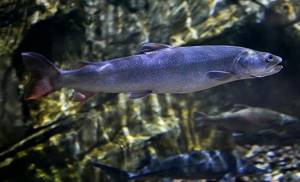
Fishing for taimen will not be successful without basic knowledge of the behavior and nutrition of the fish. This one of the largest representatives of the salmon species differs in habits from its relatives and prefers to live in fresh waters, never going into the seas and oceans. Only the Sakhalin branch of the population stands out from the general series, living in the Sea of Japan and falling under the definition of anadromous type. A clear predator that feeds on animal food, at the beginning of its long life cycle it actively eats insects and aquatic larvae, moving with age to small and medium-sized fish, and also does not disdain a meal of small animals that fall into the water, such as mice and even squirrels.
The fish has a mouth with small teeth and is similar in body shape to other salmon representatives. The size of taimen is impressive. A fish weighing 5–10 kg is considered a fry. But individuals weighing 20-30 kg are already fully mature specimens worthy of the title of trophy. Among local old-timers who specialize in catching taimen, stories of catching fish weighing 50–60 kg and 1.5 meters long are persistently cultivated, although the real limit of the growth potential of the largest representative of the salmon species for ichthyology still remains an unexplored corner of its life.
Catching taimen with a spinning rod: recommendations from professionals
This fish is the largest representative of the salmon family. An adult can weigh up to 60 kg and measure up to 1.5 meters in length. But these are only assumptions, since no one knows exactly how big taimen can grow to.
This is due to the fact that its main habitat is in hard-to-reach areas that can only be reached by helicopter. Despite this, taimen is included in the Red Book and it is prohibited to catch it in some Siberian rivers. Taimen prefers rivers with crystal clear, cool water.
Clean and cold water can be found in the most inaccessible areas of the taiga, as well as in mountain rivers. Taimen can be found in all large reservoirs of Siberia, the Far East, Altai, as well as in the northern regions of Kazakhstan. Taimen prefers fresh water, so it cannot be found at the mouths of rivers flowing into the sea.
The only exception is the Sakhalin taimen, which lives in the Sea of Japan, although it goes into rivers to spawn. Sakhalin taimen can be safely called transitional.
Habitat
Basically, taimen lives in large rivers, 400 km or more in length, although it can also be seen in rivers of shorter length. Closer to the northern regions, taimen are larger, and their numbers are not small. This is due to the fact that in such areas it is not so easy to meet people. Large taimen are found:• In the Lena River basin.
• In the Yenisei River basin. • In the Amur River basin. • In Lake Baikal. These are the largest bodies of water in Siberia in which you can catch large taimen. Such specimens are found in fast northern rivers, but it is very difficult to get there without special transport.
Only thanks to this factor, taimen has been preserved in decent quantities, closer to the northern regions.
In cities such as Irkutsk, Krasnoyarsk, Mirny, Ulan-Ude, Yakutsk, etc., taimen can no longer be caught, since it is not there or it is present, but in such small quantities. Regions of southern Siberia, such as Altai and Sayan, also belong to areas where there is practically no taimen.
Promising habitats of taimen
Taimen tries to stay in the middle or lower parts of rivers, and rises to the upper reaches to spawn. Taimen prefers places rich in food. It eats smaller salmon such as whitefish and grayling. If the location where such “trifles” accumulate is determined, then the presence of taimen in this area can be guaranteed.
However, it will not be present in areas of measured water movement. You should fish in places where there are obvious obstacles or obstacles, where the water begins to boil and its speed increases. But there may be:• Whirlpools.• Rapids.• Deep holes.• Spit.• Arrows.• Depth changes.• Rocks and boulders protruding from the water.• Underwater ridges.• Confluences of small rivers.
• Obstacles that cut the flow.
Taimen feeds on small fish, which also prefer similar places. In such places she feels safe. Taimen is also called red pike due to the similarity of their behavior and mouth structure. Medium and small individuals gather in flocks, while larger specimens prefer solitude.
Tackle for taimen
The most popular tackle for catching taimen is a spinning rod. A fairly powerful rod is used, since a fairly large specimen can bite, although smaller taimen resist quite strongly.
To do this, take a two-handed rod, about 3.5 meters long, or even more. The thickness of the fishing line is chosen to be at least 0.7 mm. If you take a thinner line, then a break is guaranteed at the first bite. Unlike pike, taimen are not able to bite through the fishing line, so it makes no sense to use leashes.
Particular attention should be paid to the choice of hooks, because this fish has a powerful jaw. A powerful fishing rod must be equipped with an equally reliable and powerful reel. At least one hundred meters of fishing line should be wound on the reel so that you can starve it out.
A pre-adjusted friction brake can be equally important. It will help dampen the powerful jerks of strong fish.
Lures for catching taimen
The fish is so voracious that it does not overload with bait and is capable of attacking anything that moves. Very often stones and sticks are found in the stomach of taimen. Most likely, he attacked the pieces of wood floating by. It swallows stones while attacking prey closer to the bottom. But this does not mean at all that taimen is always so active.
Unfortunately, this is not the case and there are times when he refuses any bait. This indicates that this fish is also influenced by different weather conditions. In such conditions, the fisherman will have to demonstrate all his skills and the entire supply of bait in order to somehow interest the predator.
Considering the size and power of the fish, baits 10-12 cm long and of suitable weight are suitable for catching it. Moreover, depending on the depth at which the wiring is carried out, baits of the required length and weight are selected.
In deep areas, heavier models of “oscillators” and “rotators” are used, and at medium depths with a slight current, the same baits, but slightly smaller in size, are more suitable. The color of the spinner plays a decisive role. The fish pays more attention to brighter specimens and attacks them first.
Many anglers claim that brass spoons are the most catchy. Moreover, in clear, sunny weather it is better to use polished, shiny models, and in cloudy weather - dull, matte specimens.
Local fishermen use the following baits to catch taimen:
Spinnerbaits: • Kola spoon. • Piggy spoon.
Rotators:
• Baikal spoon. • Kem spoon.
Modern spinners:
• Blue Fox Supervibrax – a rotating spoon for fishing at depths with calm currents. • Haukilippa from Kuusamo – a rotating spoon with a feathered tee. • Kuusamo Rasanen and Professor – an oscillating spoon designed for fishing riffles in the presence of a fast current.
As a rule, spinners No. 6 are selected, which allows for long casting. Spinner baits are used weighing from 26 g. In addition to similar baits, taimen can be caught using wobblers with a diving depth of about 1 meter. Considering the fact that there is a fast current, it is better to choose long (up to 12 cm) wobblers that have a thin shape.
Taimen attacks its bait closer to the bottom, and the retrieve should not be fast. At the moment of the bite, it may seem that the bait is caught on something, followed by a powerful jerk. If the tackle is chosen correctly, it can absorb this jerk.
The use of wobblers simplifies the task of catching taimen, since it can realistically play in the current, even without the intervention of the fisherman. The following models of wobblers showed good results: • Crystal Minnow from Yo-Zuri. • Minnow from Rapala.
Poppers are no less effective baits. An artificial mouse is highly effective, and it is best to fish at night. And there is nothing surprising about this.
Taimen easily attacks rats and mice that fall into the water, especially if they begin to move on the surface of the water.
In short, taimen is capable of swallowing anything that moves through the water and is of the right size.
When to catch
Immediately after spawning you can start catching this fish. The fishing season continues until ice appears on the rivers. If it is possible to fish even in winter, then taimen are no exception and will be hooked even in the depths of winter.
It is most active after spawning and before the onset of winter, when it needs to stock up on nutrients. Somewhere from the beginning of September until serious cold snaps, taimen actively bite both during the day and in pitch darkness.
The most productive periods are the time intervals from 8 o'clock to 10 o'clock in the morning, as well as from 17 to 20 o'clock in the evening, although it bites outside these time intervals, but not so actively. Taimen, like other fish, is seriously affected by weather conditions.
To be precise, there are changes in temperature and pressure, so taimen can shift their activity either by day or by night. Therefore, you must always be prepared for the fact that taimen will stop taking bait altogether, regardless of its type.
This type of fishing on the hard-to-reach mountain rivers of Siberia, where it is simply impossible to get to without a helicopter, can safely be called extreme.
Not only do you need special transport, you need to have special equipment, taking into account all the dangers that can await a fisherman in places where a person rarely sets foot.
And it is not surprising that recently they have begun to make money on this by organizing various tourist routes with the opportunity to fish in rivers with crystal clear water, in which taimen and other fish are found that are inaccessible for fishing under normal conditions.
Source
You may also be interested
Source: https://catcher.fish/ekspertnyi-tsentr/fishexpert/lovlya-tajmenya-na-spinning-rekomendatsii-professionalov/
Promising search places
Fishing for taimen is promising in the middle and lower parts of rivers at moderate currents. The fish rise to the upper reaches during the spawning period, during which they practically do not feed, so their captures at such points in the reservoir are quite rare and are more likely to be periodic or random. Regarding the depths, it is worth noting that taimen can stand both in shallow water and in deep areas. The main thing is that the parking area is covered with a bottom anomaly, dead wood or stones that change the speed of water flow.
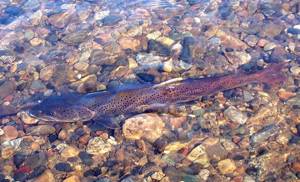
Important! It is at the boundaries of whirlpools, depth changes, in areas of stones protruding from the water, ridges of underwater boulders, and the confluence of small rivers into a large watercourse that predator sites are found.
The main food source for taimen are smaller salmon fish such as whitefish and grayling. By their massive accumulation in the river area, one can judge the giant’s ambush places. The small predator stays near ambush sites in a flock of 7–10 individuals, approximately equal in size. Particularly large predators occupy the area purely for themselves, hunting alone in selected underwater areas. Near the riffles on the shallows, not far from sandy or pebble spits, despite even the low water level, you can count on catching a solid trophy, absolutely not paying attention to this factor.
When and how to catch?
You can start catching taimen using a spinning rod in the spring after spawning, when it begins to have a short peak of activity. In summer, this fish is passive, and fishing is unlikely to be effective.
The best fishing time is morning and evening hours, when the predator is most active. The exception is night fishing with a mouse. The wiring is carried out across the current at a slow pace, imitating an animal swimming across the river.
Depending on the conditions in the fishing area, taimen are caught from the shore or by floating on a boat downstream. The bait is cast in such a way that it passes close to underwater obstacles and holes in which taimen stand.
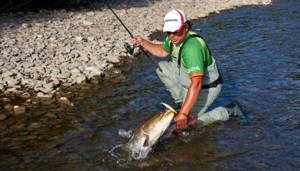
Fishing for taimen begins in June, as soon as the salmon spawn and continues until the freeze-up
It is optimal to move in the bottom layers of water at a slow or medium pace. While fishing against the current, you can stop the bait and even allow the current to carry it back, simulating a tired or wounded fish that finds it difficult to fight the current.
Read more
How to make spinning moves correctly?
When to catch
The fish is active throughout the year, and if you know where to stay under the ice, fishing for taimen in winter can bring positive results. But according to the season, the most active period is identified after the spawning of fish. This usually happens at the beginning of the calendar summer. In June, after spawning, predators begin to fatten up, bringing their nutrition to a glutton that lasts during the first two weeks of summer. Then the intensity of the bites subsides until mid-autumn, when the second wave of zhora, preceding wintering, is noticed.
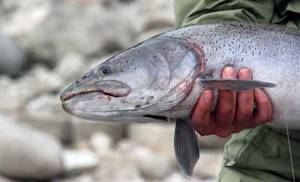
Important! During the zhor season, taimen feed throughout the day, despite the night time.
In normal mode, the fish is active from dawn until 9–10 o’clock and at sunset from dusk until complete darkness. As a rule, the effective season for catching taimen is considered to be the beginning of summer and the period of time until freeze-up, when the fish, which have gained calories, exhibit noticeably less food activity. In cloudy weather, fish take bait more readily and can feed throughout the day. The bright sun is not conducive to biting, forcing the giants to retreat into the shade and wait for more suitable conditions for feeding. In the spring, with the arrival of muddy water, even a hungry predator after winter and preparing to spawn is rarely caught.
Lures
The main baits are various spinners and a mouse. Also, look at the video of what kind of fish was pulled out on a wobbler:
Spoon
Large oscillating or rotating spoons are used as bait. Copper spoons are the best bait for taimen. Since this fish cannot be called a picky eater, he happily grabs the offered spoon.
When fishing on a cloudy day or when water clarity is poor, it is better to use shiny lures, while when visibility is good, it is better to choose a matte color. They use spinners made of two metals, one side will be yellow, the other white. Wiring should have a moderate speed, especially in medium horizons.
Spinner for taimen
Mouse
Mouse bait is usually homemade. Of course, there are also industrially manufactured baits, but fishermen prefer homemade ones. Making a mouse looks something like this: a foam cone is weighted with a lead weight so that the total weight of the bait is 50-60 grams. The length of the mouse is 10-12 centimeters for an average taimen; for trophy fish you will need to make a larger bait. The top of the cone is lined with natural or artificial fur. The mouse is equipped with one or two tees; other identification marks inherent in a real mouse in the form of a tail or ears are not needed. They cast the mouse further downstream with a spinning rod and, reeling in the reel, begin to pull the bait towards themselves. Moving against the current, the mouse forms a “whisker”, imitating a swimming animal. It’s best to “mouse” at night, but this bait also works during the day. When the bait falls on the water, a slap is made, which already alerts the taimen and encourages it to attack. When fishing with a mouse, the retrieve should be twice as slow as with a spinner. In addition to taimen, other representatives of white fish can bite on the mouse - large grayling or lenok.
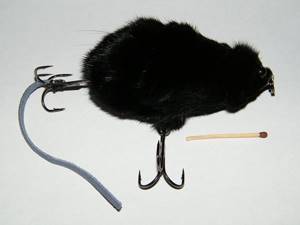
Mouse
Tackle for catching taimen
All tackle used in practice for taimen are distinguished by increased strength characteristics. The most popular and widespread fishing for predators is using a spinning rod. With a powerful spinning rod, equipped with a power reel with a well-functioning friction brake, you can count on a successful outcome in the fight against a twenty-kilogram trophy. For these purposes, forms are selected 2.5-3 meters long, with dough from 35 to 50 grams. The most practical gear is medium action, which allows you to find the optimal parameters for bait control and compensate for overloads when playing large fish in rapids. For spinning, choose a power inertialess mechanism of 4500–6000 units or a multiplier version of the mechanism close to these characteristics, equipped with a monofilament line that better withstands the requirements of fishing on abrasive bottom grounds.
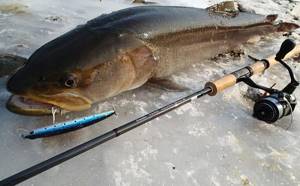
Fishing for taimen is much less common with fly fishing gear. The parameters of the whip are chosen according to the size of the fish, and therefore, they are equipped with the most massive gear of class 10–12, supplementing them with special medium-sized inertial reels with an adjustable ratchet brake. In specific places it is possible to use such gear as a boat and even a live bait float rod. When equipping installations, attention is paid to the thickness of the fishing line, which can withstand excessive loads and effectively resist abrasion on pebbles and rocky bottom soils. Hooks sharpened to perfection will help you reliably hook and hold massive fish that are frisky while playing, preventing them from getting away.
Tackle
Fishing on a raft, on the rifts, is characterized by the use of lighter gear, since casting all day long with a massive reel and a heavy blank is not easy. Take a longer rod, as you will be fishing on long casts. It is better to use long rods to move the bait among the stones.
When fishing with a mouse - a bait made of cork wood or polystyrene foam, the rod test can be 60-85 grams, while when fishing with a spinning lure, the test is below 30-40 grams. When choosing a spinning rod for taimen fishing, pay attention to the strength of the guide rings.
When rafting, you need a thicker line so as not to lose the bait.
Fishing from the shore can be done using thinner fishing line. Since the taimen will not go down the riffle, the load on the fishing line will not be large.
When talking about fishing line, I mean a nylon cord with a high breaking load, up to 1 mm in diameter. If you just use a thick cord, then when it gets wet, the windage will increase and it will be carried downstream, which will prevent the bait from sinking to the bottom.
The reel must accommodate a large amount of cord and be capacious. Use only strong triple hooks.
Lures for taimen
Taimen bite both artificial and live bait. Based on the most common fishing methods, which are spinning and fly fishing, in practice artificial imitations are more applicable and convenient. In spinning fishing, oscillating and rotating spoons are most common. Large and heavy pike spoons also work well on the taiga giant. Among the spinners, they select numbers 5–6 according to the Mepps classification, using both the Aglia and Comet types, depending on the preferences of the predator at a given moment of fishing. Spinners are used in classic colors of silver, brass and copper, selecting baits depending on the lighting - the brighter the light, the more aggressive the spinner should be in flashing and vice versa.
Recently, the popularity of minnow-type wobblers has been growing, capable of operating without failures in strong currents and having their own game. In some conditions, especially often in shallow waters, poppers are used for spinning hunting. Effective are artificial baits that resemble mice or rats in appearance, which, due to their realistic resemblance to food items, are successful in targeted fishing for trophy fish. Fly fishing uses streamers and large wet and dry flies, nymphs, bug imitations and a variety of grubs. When fishing with live bait, whitefish, small grayling or dace are used in rigs, because this is a natural and well-known food for the red fisher.
Bait for taimen
You can catch this fish on a donk, a stand, or a zherlitsa, provided that we fish with natural bait. Again, you can fish with a spinning rod, but you should keep in mind that taimen is a very strong fish and you need to select suitable gear. We take spinners: spinners and rotating ones. The ideal option would be to take spinners of different weights and sizes. Be sure to have a large supply of fishing line or braided cord. They can't be too thin, and it's not that you'll catch a big fish, it just may turn out that forced fishing is needed. On some rivers, taimen are caught using silicone rippers and are excellently caught using surface baits. If we fly fish, then most likely we will catch our prey with a mouse. Taimen are excellently caught using live bait.
Read! Choosing a reel for a feeder rod
How to catch taimen
Once again, we emphasize that fishing for taimen is limited by law and the fisherman bears considerable responsibility for the future of this fish . Therefore, regardless of the fishing methods, it is reasonable to conduct production according to the catch-and-release principle, without causing harm to the population of the rare species and promoting its further survival in natural conditions. Despite the fact that spinning takes a leading position in taimen fishing trips as the main fishing tool, from region to region one can observe local approaches to catching the predator. In the continuation of the article, we will consider a number of technologies for obtaining this coveted trophy, starting with the most popular and moving on to more exotic fishing options.
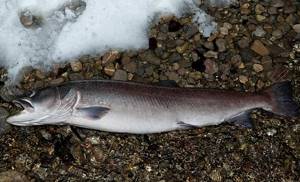
How to catch taimen using a spinning rod
Fishing for taimen with a spinning rod can be carried out in two directions: coastal hunting and hunting while rafting down the river on a motor boat. Coastal hunting in often impassable places is difficult and does not always provide the spinner with the opportunity to fish promising areas, being content with fishing in small areas approaching the water. The boat significantly expands the possibilities, which often becomes the key to success. On a motor they rise against the current, catching promising points by feeding bait against the flow of water. The predator is not very timid and, confident in its invulnerability, rarely leaves the hunting grounds due to the noise of the engine. A spinner can be successful even if his camouflage is not particularly thorough.
The main thing is to correctly determine where the fish are staying and lead the bait close to the bottom, allowing them to play through the flow of water. Large individuals prefer massive and heavy baits. Small spinners will fall prey to lenok or perch, as well as undergrowth like a couple of kilos of timefish. In riffles and shallow waters they fish from the surface, floating imitations of mice and feeding poppers to the predator. In water areas with pike, metal leashes are installed in the rig, otherwise the spinning angler faces frequent cuts from the bait of the catfish, which competes with other predators.
Fly fishing for taimen
You can fly fish for taimen in the fall and summer using an artificial mouse. They go out for fly fishing with mice closer to dusk and at night. The delicate tackle catches large, highly resistant trophies, so the equipment uses long backing, which allows the fish to escape a couple of tens of meters. In addition to mice and popper-type wobblers, streamers identical in appearance to salmon fishing, intruders, artificial leeches, fly wobblers and fly spinners are suitable for fly fishing. Taimen prefer fly baits in natural dark colors.
Fishing in other ways
Of the alternative tackles, the most popular is a boat, released with bait in the form of an artificial fly, an oscillating spoon or a soft mouse. Local residents, with centuries of accumulated experience, successfully hunt the giant using props and hooks of various designs. As bait, these specific tackles are equipped with live bait or a bunch of large worms, feeding the rigs into the fishing zones tested by the fisherman. Often, float-based live bait fishing rods are used for these purposes. On lakes and large rivers, catching the predator by trolling is quite successful. A well-chosen working wobbler for taimen is led over promising sites for the predator, picking up especially large active individuals that react to the sharp play of the bait.
Fishing for taimen
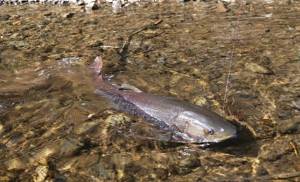
The predator is quite aggressive when playing, moreover, large fish are incredibly strong and can easily crush flimsy tackle, not forgiving of delays in reeling in a loose cord, gaining some freedom of action and maneuver for a jerk. After poking the bait, you should make a test mark, securely place the trophy on the hooks, and immediately begin pumping out the fish. It is important not to allow the predator to retreat to cover, which is often a nearby dead tree or underwater rock ridge, from where it will be almost impossible to remove densely entrenched taimen.
Often, a powerful candle at the initial stage of fishing allows the fish to spit out the hooks, so you should constantly keep the line tight, gradually tiring the fish, while simultaneously working with the rod and reel to pump out and reel in the released line. Despite its massive size, taimen is a rather delicate fish, sensitive to oxygen starvation and microtrauma from a hook, and even more so from a hook. It is recommended to hold the caught fish for as little time as possible, take a couple of wonderful photos and release it back into the river stream.
Sections
Part 1
Quiet evening. There is no wind, a light fog rose over the river, bringing damp freshness to our tent camp.
Vadim and Denis, having had negative experience of equipment being damaged in humid conditions, prudently stocked up on sealed bags and hid the cameras. That evening I was visited by something like a nostalgic feeling: a year ago, in approximately the same places, we saw the same fog and felt similar taiga smells, listening to the sound of the river. This is an indescribable feeling that can only be experienced by being there.

Morning of a new day. We get into the boat and sail up the river about forty kilometers from the camp. We decided to divide each day into two parts: from the morning until three o’clock in the afternoon we catch lenok from the shore, and in the evening we begin rafting. It is at this time that a sharp activation of taimen occurs, increasing the chance of catching the desired large individual. I already have taimen worth 10 kg, Ivashkov has 11 kg. The fish are big, strong and very beautiful, but you don’t want to stop at the achieved size. Neither me nor Ivashkov.

In the meantime, the ubiquitous lenok. True, lenca can only be called ubiquitous in these little-visited places. Fishermen I know say that within a radius of 300 km from Khabarovsk, even lenok has become rare - not to mention taimen. However, even in these fishing places far from civilization the fish are not always caught like on the “black rocks”. Today the sun is shining and there is no wind. Apparently, this was the reason for the incredibly low activity of lenok: in clear water we see whole schools of these fish that almost do not react to our baits.
I offered Lenka wobblers of various shapes and sizes - to no avail. Ivashkov decided to try spinners of size #0 - #1, and things moved forward: lenka and grayling began to periodically attack the spinners.
During the fishing process, there was a clear tendency to increase activity: moving along the channel from place to place, bites became more frequent and powerful. Today I took with me an ultralight - Megabass Shoreluck SLL68ULT, equipped with my favorite trout reel Daiwa Exist'15 2003F-H with Daiwa Presso Durabra 4Lb monofilament. This set, which I usually use to catch brook and chub on rivers in my region, is ideal for high-quality fishing with small spinners. I used spinners from the Trait series from Pontoon21 in the smallest sizes: #0 and #00.

Frankly, this turned out to be the most effective way of catching capricious fish in this channel: bites occurred on almost every trip, and both grayling and lenok of different sizes were caught.
At three o'clock in the afternoon, as planned, we go out to the main river and begin rafting. I put the bait in which I now believe more than any other - this is the Pontoon21 Cablista 125SP-MSR. And Ivashkov, apparently drawing an analogy with a large taimen caught on a small spinner, decided to catch with a spinner.

Quite quickly my wobbler came under attack - it’s a decent lenok.

The second one was caught behind him.

Alexey, looking at this, asked to give him some kind of effective wobbler, but not the same as mine. I open the box and without hesitation I take out the DUO Realis Jerkbait 100SP. In all its characteristics, this minnow is excellent for rafting conditions, and besides, Ivashkov has already fished with it. In one of the places we landed on the shore and decided to more carefully fish the reach under the cliff of the hill. Lyosha immediately managed to seduce an excellent lenok, which he caught closely near the shore.

We continue the rafting. Here, in the wild, bait, even if there is a very large supply, is especially valuable. For some unknown reason, each of us is trying with all our might to avoid losses, so when we got hooked, we fought to save every wobbler.
But, alas, this did not work out every time.
The day for which we had pinned a lot of hopes flew by in a blink of an eye. We caught a lot of lenks, but not a single taimen of a worthwhile size. Like any fish, the activity of taimen, especially large ones, depends on a whole host of factors, of which we can only trace and understand a small part.
The morning of a new and last day of our stay in the taiga. The bright sun is shining, there are only lonely rare clouds in the sky. We load gear and equipment into the boat and sail up.
We plan the day according to the usual schedule: lenok until three o’clock in the afternoon, and after that – rafting. We were very pleased with the activity of the lenok today: we caught 3-6 fish from each place.
Unexpectedly, the Megabass Darter 80 Jr. wobbler became a favorite when fishing for lenka, which I set up just to try.

Lenks attacked it much more often than any of the baits we offered. To get a bite, it was not at all necessary to move the bait jerkily, but simply throw it to the center of the riverbed and hold it for drift.
Darter Jr. has an active game of its own, so it works great in this fishing mode.
However, you need to try different wiring options, and it is always useful to select different baits. This time, an excellent addition was the DUO Realis Minnow 80, which I carried out in a typical trout version of twitching.
Catching lenka is certainly very interesting. As a big fan of trout fishing (exclusively wild fish in rivers with strong currents), I liked this type of fishing. The average size of the lenok is especially pleasing - more than a kilogram! Some individuals even reach three!
And in appearance, and in habits, this fish is very similar to the usual brook trout. However, in addition to lenok, our area of interest here also includes its larger brother - taimen. At the appointed hour we begin rafting in the hope of catching a large fish.
Everyone who has at least some experience in catching taimen claims that its activity is wave-like: today there is not a single bite, and tomorrow there is a bite like from a machine gun. Oh, how familiar this is... Perhaps nothing unites the habits of all predatory fish like this feature. Personally, in some conditions I was able to determine at least some bindings, in relation to which it is possible to predict whether there will be a bite or not. For example, the winter estuaries of the Azov region always work for pike exclusively in southern winds, while in northern winds it is extremely difficult to catch anything - you don’t even have to go fishing. What taimen is tied to is not yet clear to us. And none of the experienced timeshaters have yet offered their versions. Therefore, there is only one thing left to do - cast and believe that he will bite. Looking ahead, I will say that today everything was a success. But! Why?! The weather is exactly the same as yesterday, without even the slightest change. Apparently, this is the case when we encountered a surge of unpredictable activity. It’s fair to say that this happens in any conditions and with any fish.
Let's start the rafting. Ivashkov, believing in “hardware,” decided to continue fishing with spinners. And I, convinced of the correct choice of a large minniu wobbler, today made a bet on the Pontoon21 Cablista 125SP.
We begin the rafting at the scheduled time. The first promising place that we had to go through was a long (250-300 m) and deep reach under the high bank of one of the hills. The place is quite wide to effectively fish it; we pressed ourselves against the shallower left side of the reach in order to make long casts to the right. In the center the depth is about three meters; a sharp slope strewn with large boulders leaves the steep bank. With a long cast, I was able to place the wobbler right at the shore, which I decided to cast at an accelerated pace for more efficient fishing of a vast area, alternating jerking retrieves with quick pulls.
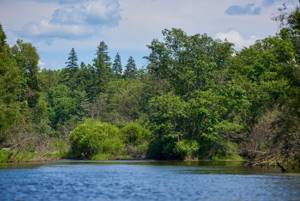
Usually rafting looks like something monotonous: the boat floats downstream, and your task is to make as many casts as possible without missing out on promising places. This is exactly the case when quantity (casts) can develop into quality. Therefore, at the very beginning of the rafting, you always tune in internally to this monotony, not expecting that something worthwhile might bite almost immediately... However, you always need to be prepared for this: at the end of the reach I make another long cast, start retrieving and, when the bait was already ten meters from the boat, a powerful blow happens! Hooking is heavy! I peer into the water and see how a huge side of taimen is turning out in the thickness... I shout: “Yes!!! Eat!!! Yes!!!”, and as if in a state of passion, I can’t believe my own feelings...
Sergei starts the engine, gives everyone the command: “Sit down,” and carefully, slowly guides the boat to the spit, which begins immediately at the exit from the reach. Rybina, sensing something was wrong, quickly rushed back into the reach against the powerful current, unwinding about forty (!!!) meters of cord from the clutch! I am confident in my gear, so I don’t worry about the integrity of the cord. And I installed more powerful hooks: Owner ST56BC #4 instead of the original Owner ST46TN #4.
When the taimen entered the shallow water, my rod really started working, and every now and then it had to fend off the jerks of the big fish.

At the moment when the taimen felt the shallow water, it made several powerful attempts to go into the depths and even jumped out of the water!

However, this agility completely tired him and, bringing the fish to me, I recorded the catch!

This is definitely my largest taimen at the moment!
The weight of the fish is exactly 15 kilograms!
There are marks on the adipose fin - this fish has already been caught before me. I am glad that the taimen were released. I, of course, in turn, am obliged to return the inhabitant to the river and I do this with the same pleasure that I received from his capture!
There’s nothing left to say here... My consciousness is “frozen”, now I need time to move away and come to my senses.

I know that someone will say: “Just think, taimen... Only 15 kg...” But, you know, I really sincerely share my own emotions and feelings. After all, I live many thousands of kilometers from the nearest taiga rivers inhabited by taimen, which is why all this is so emotional for me. Perhaps, years from now, re-reading this story, I will laugh at myself, by that time having 25...30 kg of taimen under my belt. However, every moment has its time. Once upon a time, even a three-kilogram pike seemed to me a serious trophy, but now it’s a standard and nothing more.
Having caught our breath a little, we continue the rafting. Vadim Grushko, having filmed such an exciting story, decided that the job was done and changed the camera to a spinning rod. For me, this taimen gave me a feeling of a completed mission; now I was not burning with the same desire to catch a big fish as half an hour ago. But there is still a lot of time before twilight, so we continue to fish.
During rafting, most often, however, you come across lenkas. But, due to the use of large baits, the average size of lenoks is also not small. Sometimes, after a bite, individual fish make you think that there is a small taimen on the hook.
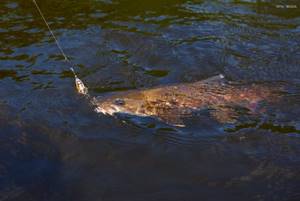
Another taimen, albeit a very small one, was caught by Ivashkov using a Pontoon21 Indi-Rah lure.
This little guy pecked under the crease - in a classic way.
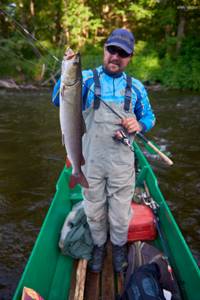
Then he replaced the lure with a DUO Realis Jerkbait 100SP wobbler, and from the next pit he hooked a larger fish, for which he asked Sergei to land on the shore.
Following the time from the next stretch, Ivashkov caught a decent lenok.

Vadim asked for some kind of vibration. I gave him a Pontoon21 Sinuoso Spoon 14 g from my box. From the very first cast he caught a small timefish.

Behind him is Lenka.

Our director is gone! I decided to make up for all the days I watched fishing only through the camera viewfinder.
Already on the next stretch, his lure was attacked by larger than average taimen.
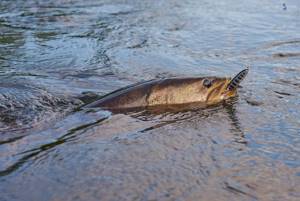
Vadim usually remains behind the scenes of all our filming, but now this is a rare case when he is in the focus of the lens.
The weight of his fish is almost 7 kg.

It's great that Vadim caught this taimen. We travel a lot and catch different fish. On each trip, he tries to catch new fish in his free time from filming. On this trip to the Far East, Vadim managed to add three new species to the list: snakehead, lenok, and now taimen.

The sun has already “fallen” behind the forest, twilight will soon come. I decided to slowly start collecting gear. Ivashkov does not miss the last opportunities, continuing to catch. He alternates between spinners and wobblers. On the next stretch, having thrown a small spinner Indi-Rah #3 , it was attacked by taimen.

We land on the shore, where Alexey carefully and slowly brings the fish into the shallow water - eat!
That's it, this is definitely the finish line! The highlight of a long day and the entire trip! I won’t even comment on anything, the photo perfectly conveys our delight!
Last year’s visit to these places made a huge impression on me, I thought it couldn’t get better. But, as it turned out, Sikhote-Alin was modest then and revealed all the hidden potential of abundance to us now. Now I am no less in love with this mountain range than with my native Caucasus. Of course, there are no such high peaks and snow-capped peaks here, but it has its own charm. You can feel it only by being here once.

See you again, Sikhote-Alin! I'll come back!

